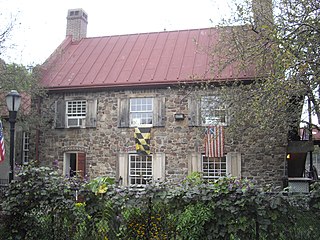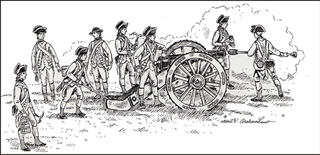
The Old Stone House is a house located in the Park Slope neighborhood of Brooklyn, New York City. The Old Stone House is situated within the J. J. Byrne Playground, at Washington Park, on Third Street between Fourth and Fifth Avenues. Gowanus Creek once ran nearby, but today the southeastern branch of the Gowanus Canal ends 1,300 feet (400 m) west of the house.

The Battle of Cowpens was an engagement during the American Revolutionary War fought on January 17, 1781 near the town of Cowpens, South Carolina, between American Patriot forces under Brigadier General Daniel Morgan and British forces, nearly half American Loyalists, under Lieutenant Colonel Banastre Tarleton, as part of the campaign in the Carolinas. The battle was a turning point in the American reconquest of South Carolina from the British.

William Smallwood was an American planter, soldier and politician from Charles County, Maryland. He served in the American Revolutionary War, rising to the rank of major general. He was serving as the fourth Governor of Maryland when the state adopted the United States Constitution.
John Haslet was an American Presbyterian clergyman and soldier from Milford, in Kent County, Delaware. He was a veteran of the French and Indian War and an officer of the Continental Army in the American Revolution, serving as the first Colonel of the 1st Delaware Regiment. He was killed in action at the Battle of Princeton.
The 1st New Hampshire Regiment was an infantry unit that came into existence on 22 May 1775 at the beginning of the American Revolutionary War. John Stark was the regiment's first commander. The unit fought at Chelsea Creek and Bunker Hill in 1775. On 1 January 1776, while engaged in the Siege of Boston, the unit was renamed the 5th Continental Regiment. In the spring it was sent to Canada where the New Hampshire soldiers fought at Trois-Rivières and later helped defend the area around Lake Champlain. Late in the year, the 5th Continental Regiment was transferred south to George Washington's main army where it fought at Trenton.

The 2nd Maryland Regiment origins were authorized on 14 January 1776 in the Maryland State Troops as seven independent companies. From 7 to 14 March 1776 the companies were organized from various counties from the eastern region of the colony of Maryland. From 6 July to 15 August 1776 the companies were assigned to the main Continental Army and officially adopted on 17 August 1776. In January 1777 the seven companies were organized as the 2nd Maryland Regiment with one additional company added. On 22 May 1777 the regiment was assigned to the 2nd Maryland Brigade in the main Continental Army. On 12 May 1779 the regiment was re-organized to nine companies. The 2nd Maryland Brigade was reassigned to the Southern Department on 5 April 1780. On 1 January 1781 the regiment was reassigned to the Maryland Brigade of the Southern Department. The regiment would see action during the New York Campaign, Battle of Trenton, Battle of Princeton, Battle of Brandywine, Battle of Germantown, Battle of Monmouth, Battle of Camden and the Battle of Guilford Court House. the regiment was furloughed 1 January 1783 at Charleston, South Carolina and disbanded on 15 November 1783.
The 3rd Maryland Regiment was an infantry regiment of the Continental Army during the American Revolutionary War. It served from 1776 to 1783, mostly in the Middle Atlantic Region of the conflict.
The 5th Maryland Regiment is a designation which has been held by several units over the years, not all of which necessarily share the same lineage and honors. The term "5th Maryland" has most frequently been connected to militia units in Baltimore, even though the first unit to bear the designation was formed in 1776 from volunteers in rural Maryland. The "5th Maryland" designation is the officially recognized traditional designation of the 175th Infantry Regiment, Maryland Army National Guard. This entry refers to the rural 5th Maryland, whose lineage is separate and distinct from the Baltimore 5th Maryland perpetuated by the 175th Infantry Regiment.

The 6th Maryland Regiment, active from 27 March 1776—January 1, 1783, is most notable for its involvement during the American Revolutionary war of the same years. An infantry type regiment consisting of 728 soldiers, the 6th Maryland was composed of eight companies of volunteers from Prince Georges, Queen Anne's, Fredrick, Cecil, Harford, and Ann Arundel counties in the colony of Maryland

The 7th Maryland Regiment was authorized on 16 September 1776, for service with the Continental Army and was assigned on 27 December 1776. The regiment was composed of eight companies of volunteers organized from Frederick and Baltimore counties of the colony of Maryland.

The "Maryland Line" was a formation within the Continental Army, formed and authorized by the Second Continental Congress, meeting in the "Old Pennsylvania State House" in Philadelphia, Pennsylvania in June 1775.

The North Carolina Line refers to North Carolina units within the Continental Army. The term "North Carolina Line" referred to the quota of infantry regiments assigned to North Carolina at various times by the Continental Congress. These, together with similar contingents from the other twelve states, formed the Continental Line. The concept was particularly important in relation to the promotion of commissioned officers. Officers of the Continental Army below the rank of brigadier general were ordinarily ineligible for promotion except in the line of their own state.
A flying camp was a military formation employed by the Continental Army in the second half of 1776, during the American Revolutionary War.

The 175th Infantry Regiment is an infantry regiment of the Maryland Army National Guard. It is one of several National Guard units with colonial roots and campaign credit for the War of 1812.

The 1st Continental Artillery Regiment, also known as Harrison's Continental Artillery Regiment, was authorized on 26 November 1776 as Colonel Charles Harrison's Continental Artillery Regiment. Raised for service during the American Revolutionary War, as originally organized, the regiment comprised 10 artillery companies from Virginia. Two of the artillery companies existed since early 1776. The regiment was first assigned to the Southern Department, but in March 1778 it was reassigned to General George Washington's main army. In August 1779, the unit was renamed the 1st Continental Artillery Regiment. It continued to serve with the main army until April 1780 when it was transferred to the Southern Department. In May 1780, Maryland artillery companies formally joined the regiment, making a total of 12 companies. In January 1781, the regiment was reorganized with 10 companies. Furloughed in the summer of 1783, the regiment was disbanded in November the same year. Elements of the regiment fought at Monmouth, Charleston, Camden, Hobkirk's Hill, Eutaw Springs, Yorktown, and Combahee River.
Charles Harrison was born into the noted Harrison family of Virginia. His brother was a signer of the Declaration of Independence and his nephew William Henry Harrison later became president. At the beginning of the American Revolutionary War he became lieutenant in a company of artillery from Virginia. When the state expanded its small artillery battalion into a regiment in November 1776, Harrison was appointed commander with the rank of colonel. Initially named Harrison's Continental Artillery Regiment, the unit was renamed the 1st Continental Artillery Regiment in August 1779. He joined George Washington's main army in time to fight at Monmouth. In 1780 he led his gunners at Camden and the following year he commanded Nathanael Greene's artillery at Hobkirk's Hill.
The "German Battalion" was an infantry formation of the Continental Army during the American Revolutionary War. Authorized in May 1776 as an extra Continental regiment, the battaltion recruited ethnic Germans from Maryland and Pennsylvania.

The Maryland 400 were members of the 1st Maryland Regiment who repeatedly charged a numerically superior British force during the Battle of Long Island during the Revolutionary War, sustaining heavy casualties, but allowing General Washington to successfully evacuate the bulk of his troops to Manhattan. This action is commemorated in Maryland's nickname, the "Old Line State." A monument in Brooklyn and multiple plaques were put up in the memory of this regiment and the fallen soldiers.












